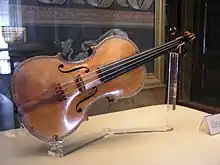Stradivarius Palatinos
The Stradivarius Palatinos are a set of five string instruments made by Antonio Stradivari around 1700. They are kept in Madrid's Royal Palace. The term "Palatino" can in this case be translated as "court" instruments,[1] as it refers to their belonging to the Spanish royal collection.

Four of the five are decorated instruments known as the Royal Quartet (also referred to in Spanish as Palatino or Coral): they comprise 2 violins, a viola and a cello. There is also another (non-decorated) cello.
The Royal Quartet
Decorated instruments are rare in Stradivari' output, and so are sets of instruments. A few of his clients are known to have acquired sets, for example, Ferdinando de' Medici, Grand Prince of Tuscany (son of Cosimo III de' Medici, Grand Duke of Tuscany). In the case of the Palatinos, Stradivari intended to present them to the king of Spain but was not able to do so during his lifetime.
An ensemble of 2 violins, a viola and a cello is what is referred to in classical music as a string quartet, and many works have been written for this combination since the 18th century. For example, the Spanish royal family was the patron of Boccherini, who wrote over a hundred works in this genre.[2] However, Stradivari never heard the type of composition known as a "string quartet", the format emerged after his death. The project to provide instruments for the Spanish court evidently envisaged a different ensemble, as instead of having only viola, the set originally had two.
Violas
There were originally two violas of different size in the set (tenor and alto). Both of the violas went missing at the time of the Napoleonic Wars.[1] Only the alto was retrieved. The loss of the tenor viola has made a limited difference to the ensemble in the sense that the alto voicing has become the normal one for violas.
Alto viola
The alto viola is dated 1696. It returned to Madrid in the 20th century after having come into the possession of the dealer W.E. Hill & Sons of London. It is one of thirteen known extant violas by Stradivari.[3] It is unusual in being decorated, although a tenor viola in Florence (discussed below) is adorned with the Medici crest on the fingerboard.
Tenor viola
The missing viola was larger and is believed to have been a tenor. The "Medici" tenor viola by Stradivari in the Musical Instruments Museum in Florence also had an alto pair: they were both part of a set belonging to the Medici court.[4] The role of tenors would have been to play the lower register viola lines or second viola in five-part harmony depending on instrumentation.
Violins
The two violins are of different sizes. They have labels bearing a date of 1709. This dating is accepted by some authorities,[5] although it has been suggested that the instruments are slightly older.
Cello
The cello is not in its original playing condition, having been modernised. It is reported to be in a good state of conservation after the repair of damage sustained during a photographic session.[6]
Conservation
The instruments are in the care of the Spanish heritage organisation Patrimonio Nacional, which allows them to be played on occasion. Musicians who have played them in recent years include the Quatuor Mosaïques (a group which specialises in period instruments) and the Cuarteto Quiroga.[7]
Recordings
The Quatuor Mosaïques made a recording in 2006.[8]
References
- "Spanish court (viola 40261)". Cozio Archive. (subscription required)
- Marín, Miguel Ángel (2017). “Haydn, Boccherini and the rise of the string quartet in late eighteenth-century Madrid”, in Christiane Heine and Juan Miguel González Martínez (eds.), The String Quartet in Spain.
- Small, Lawrence M. (December 2002). "Fanciful and Sublime". Smithsonian. Archived from the original on 2002-12-24. Retrieved 2008-02-05.
- "Medici, Tuscan (viola 41401)". Cozio Archive.
- "Royal Palace in Madrid". Cozio Archive. Retrieved 2020-08-31.
- "El Stradivarius accidentado del Palacio Real". ABC (in Spanish). September 2012. Retrieved 30 August 2020.
- "Música de cámara". Patrimonio Nacional (in Spanish). 2017.
- OCLC 430971632